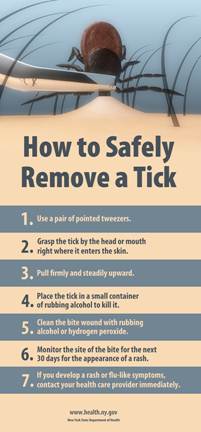Modified: May 10, 2017 3:37pm
Latest News

PRESS RELEASE
From the Office of the Commissioner of Health, Dr. Gale R. Burstein
Date: May 10, 2017
CONTACT: Mary C. St. Mary/Mary.StMary@Erie.Gov
Phone: 716.858.4941/ Mobile: 716.253.3925
How to Protect Yourself from Ticks
Common Sense Prevention & Alert Observations are Recommended
ERIE COUNTY, NY— After another mild Western New York winter, the number of ticks in Erie County may be increased compared to previous years. More ticks could lead to more people exposed to tick borne diseases, such as Lyme disease, which is widespread in Erie County.
This year, Centers for Disease Control and Prevention (“CDC”) experts and other health researchers are warning of another disease carried by ticks, Powossan virus. While Powassan is still very rare, it is too early to predict if Powassan is truly becoming more prevalent.[1]
Powossan virus causes encephalitis—or swelling of the brain—and kills about 10% of people who become ill while other victims may sustain permanent neurological damage. According to the New York State Department of Health, since the early 1990’s, the New York State Western Region (17 Western Counties) has not reported any Powassan virus cases. However, while rare, Powassan exists in areas where Western New Yorkers may travel for business or recreation.
“April to September is a very active time of year for ticks,” said Peter Tripi, Senior Public Health Sanitarian. “Nymphs and overwintering adults are seeking a blood meal. In the mid-summer, active larvae can be found on mice as hosts until they become nymphs and jump off, seeking their next meal. Both ticks and humans have tested positive for Lyme disease in Erie County.”
“Should you discover a tick on your skin, carefully remove the entire tick and observe for signs and symptoms of disease,” said Dr. Gale Burstein, Erie County Commissioner of Health. “The sooner the tick is removed, the less likely that an infectious disease is transmitted. Transfer of an infectious agent depends on the tick’s feeding interval or period of attachment and whether the tick was removed properly. Generally, the tick must be attached to an individual for 36 to 48 hours or more before it can spread bacteria. Ultimately, a person with known (or suspected) history of tick bite needs to consult with a healthcare provider for assessment of symptoms, which may or may not lead to a diagnosis of a tick-borne disease. Not all ticks bites lead to Lyme disease or Powassan virus.”
Ticks, especially in the nymph stage, are extremely small so a thorough skin and clothing inspection is necessary after spending time outdoors where ticks are present or suspected. In tick infested areas, try to avoid contact with soil, leaf litter and vegetation. If you garden, hike, camp, hunt, work or otherwise spend time in the outdoors, take steps to protect yourself.
Burstein added: “After spending time outdoors in an area likely to have ticks, such as brushy, woody or grassy places, it is very important that you check yourself, your children and your pets for ticks.”
What Can I Do To Reduce Ticks In My Yard?
- Keep lawns mowed and edges trimmed
- Clear brush, leaf litter and tall grass around the house, and at the edges of gardens and stone walls
- Stack woodpiles neatly away from the house and preferably off the ground
- In the fall, clear your yard of all leaf and garden litter, where ticks can live in the winter
- Keep the ground under bird feeders clean so as not to attract small animals that can carry ticks into your yard
- Locate children's swing sets and other play equipment in sunny, dry areas of the yard, away from the woods where ticks can be abundant
- Using an approved insecticide once a year (in June) can significantly reduce tick numbers on a residential property

Avoid Direct Contact with Ticks
- Avoid wooded and brushy areas with high grass and leaf litter.
- Walk in the center of trails. Stay on cleared trails when walking or hiking; avoid the edge habitat where ticks are likely to be.
Repel Ticks on Skin and Clothing
- On children older than 2 months of age and adults, use repellent that contains 20 percent or more DEET, picaridin, or IR3535 on exposed skin according to the instructions given on the product label for protection that lasts several hours.
- Always follow product instructions. Parents should apply this product to their children, avoiding hands, eyes, and mouth. Insect repellents also are not recommended for children younger than 2 months.
- Use products that contain permethrin on clothing. Treat clothing and gear, such as boots, pants, socks, camping gear and tents with products containing 0.5% permethrin. It remains protective through several washings. Pre-treated clothing is available and may be protective longer. Do NOT apply to skin.
- Wear a long-sleeved shirt and long, light-colored pants tucked into socks or closed-toed shoes. While this may be difficult to do during hot weather, it will help keep ticks away from your skin and help you spot a tick on your clothing faster.
- To keep your pets safe, talk to your veterinarian about effective tick control options
Find and Remove Ticks from Your Body
- Bathe or shower as soon as possible after coming indoors (preferably within two hours) to wash off and more easily find ticks that are crawling on you.
- Conduct a full-body tick check using a hand-held or full-length mirror to view all parts of your body upon return from tick-infested areas. Parents should check their children for ticks under the arms, in and around the ears, inside the belly button, behind the knees, between the legs, around the waist, and especially in their hair.
- Examine gear and pets. Ticks can ride into the home on clothing and pets, then attach to a person later, so carefully examine pets, coats, and day packs.
- Tumble dry clothes in a dryer on high heat for 10 minutes to kill ticks on dry clothing after you come indoors. If the clothes are damp, additional time may be needed.If the clothes require washing first, hot water is recommended. Cold and medium temperature water will not kill ticks effectively. If the clothes cannot be washed in hot water, tumble dry on low heat for 90 minutes or high heat for 60 minutes. The clothes should be warm and completely dry.
# # #
For More Information:
Erie County Department of Health-Stop Ticks
New York State Department of Health-General Information about Lyme disease & Tick Bite Prevention
New York State Department of Health Information about Tick Repellent
Centers for Disease Control and Prevention-Ticks
Centers for Disease Control and Prevention-Powossan Virus
Environmental Protection Agency-Select Proper Insect Repellant
[1] TIME Magazine, Powassan Virus Is the Scary New Reason to Avoid Ticks, Amanda MacMillan, 5/4/2017

